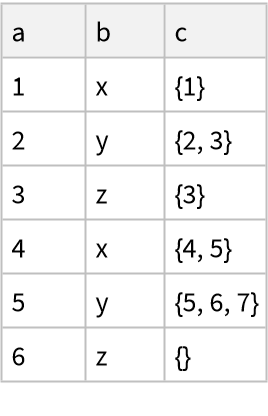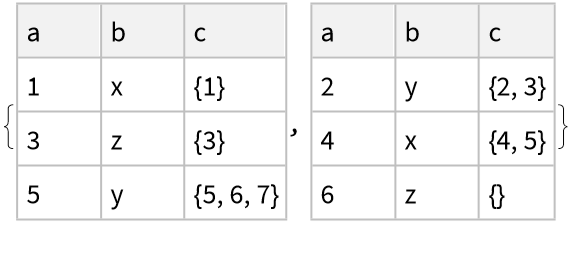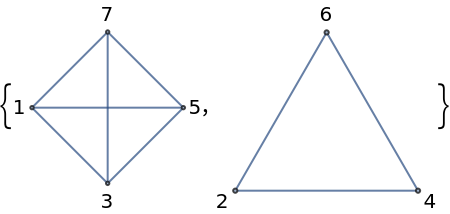Basic Examples (5)
Separate elements that are even:
Use a pure function to test each element:
Select only the first expression that satisfies the condition:
Use the operator form of SelectDiscard:
SelectDiscard operates on values in an Association:
Scope (6)
SelectDiscard gives elements for which applying the criterion explicitly yields True in the first list and everything else in the second:
Applying the criterion to the symbolic object x does not explicitly yield True:
Find pairs containing x:
Find up to 2 pairs containing x:
Fewer than the requested elements may be returned:
Use an operator form as the selection criterion:
Use SelectDiscard in operator form:
Separate arguments in Unevaluated code:
Generalizations & Extensions (4)
SelectDiscard works with any head, not just List:
SelectDiscard works with SparseArray objects:
The result includes a list since only one can be sparse:
Compare to Select:
Separate a Dataset:
Separate a Graph by testing its vertices:
Applications (5)
Select numbers up to 100 that equal 1 modulo both 3 and 5:
Select 4-tuples that read the same in reverse:
Select eigenvalues that lie within the unit circle:
Separate built-in Wolfram Language symbols based on whether their names contain less than 10 characters:
Select numeric quantities from a product:
Properties & Relations (7)
The lengths of list1 and list2 will always sum to the length of the original list:
When specifying a maximum, the second list can contain elements that satisfy the given condition:
SelectDiscard is similar to TakeDrop except it takes/drops elements using the given function:
For crit that always return True or False, SelectDiscard is very similar to GatherBy:
However, the first list returned by SelectDiscard always corresponds to elements ei where crit[ei] gives True:
Similar results can be obtained with GroupBy:
However, SelectDiscard works on expressions with any head:
GroupBy does not:
SelectDiscard always gives two lists:
Compare with GatherBy and GroupBy:
Similar results can be obtained with a combination of Select and DeleteElements:
SelectDiscard tends to perform better with large lists:
The first list returned by SelectDiscard[list,crit] is equivalent to what's returned by Select[list,crit]:
The second list is effectively equivalent to Select[list,Not@*TrueQ@*crit]:
Possible Issues (1)
When specifying a limit, the second list can contain elements ei where crit[ei] is True:
![dataset = Dataset[{
<|"a" -> 1, "b" -> "x", "c" -> {1}|>,
<|"a" -> 2, "b" -> "y", "c" -> {2, 3}|>,
<|"a" -> 3, "b" -> "z", "c" -> {3}|>,
<|"a" -> 4, "b" -> "x", "c" -> {4, 5}|>,
<|"a" -> 5, "b" -> "y", "c" -> {5, 6, 7}|>,
<|"a" -> 6, "b" -> "z", "c" -> {}|>}]](https://www.wolframcloud.com/obj/resourcesystem/images/02b/02b0e831-cd44-4eac-84f5-9072e70bffc7/36d2e3950fad67d3.png)


![ResourceFunction["SelectDiscard"][\!\(\*
GraphicsBox[
NamespaceBox["NetworkGraphics",
DynamicModuleBox[{Typeset`graph = HoldComplete[
Graph[{1, 2, 3, 4, 5, 6, 7}, {Null,
SparseArray[
Automatic, {7, 7}, 0, {1, {{0, 6, 12, 18, 24, 30, 36, 42}, {{2}, {3}, {4}, {
5}, {6}, {7}, {1}, {3}, {4}, {5}, {6}, {7}, {1}, {2}, {
4}, {5}, {6}, {7}, {1}, {2}, {3}, {5}, {6}, {7}, {1}, {
2}, {3}, {4}, {6}, {7}, {1}, {2}, {3}, {4}, {5}, {7}, {
1}, {2}, {3}, {4}, {5}, {6}}}, Pattern}]}, {GraphLayout -> {"CircularEmbedding", "OptimalOrder" -> False}, VertexLabels -> {"Name"}}]]},
TagBox[GraphicsGroupBox[{
{Hue[0.6, 0.7, 0.5], Opacity[0.7], Arrowheads[0.], ArrowBox[CompressedData["
1:eJxTTMoPSmVmYGAQBWImKPa/x1p6mOXl/htvux8t+PzYPuNlBOsco/f7412Z
Hk+oPrMfXX776kLfA0du78+NOb1yz5U3GPLnIPL2pTjksyDm26/CYb47hG9/
EspHl6+NvbFmY+LJPQxg8AHDvejuQ5dHdx+6PLr70OXR3Ycuj+4+dPeg248u
j24/ujy6/ejy6Paj24duPro8uvno8ujmo5uHrh9dHl0/unp0eQBAEHt7
"], 0.022203]},
{Hue[0.6, 0.2, 0.8], EdgeForm[{GrayLevel[0], Opacity[
0.7]}], {DiskBox[{-0.78183, 0.62349}, 0.022203], InsetBox["1", Offset[{-2., 1.5949}, {-0.80161, 0.63926}], ImageScaled[{1., 0.10126}],
BaseStyle->"Graphics"]}, {DiskBox[{-0.97493, -0.22252}, 0.022203], InsetBox["2", Offset[{-2., -0.45649}, {-0.99685, -0.22753}], ImageScaled[{1., 0.61412}],
BaseStyle->"Graphics"]}, {DiskBox[{-0.43388, -0.90097}, 0.022203], InsetBox["3", Offset[{-0.96315, -2.}, {-0.44405, -0.92207}], ImageScaled[{0.74079, 1.}],
BaseStyle->"Graphics"]}, {DiskBox[{0.43388, -0.90097}, 0.022203], InsetBox["4", Offset[{0.96315, -2.}, {0.44405, -0.92207}], ImageScaled[{0.25921, 1.}],
BaseStyle->"Graphics"]}, {DiskBox[{0.97493, -0.22252}, 0.022203], InsetBox["5", Offset[{2., -0.45649}, {0.99685, -0.22753}], ImageScaled[{0., 0.61412}],
BaseStyle->"Graphics"]}, {DiskBox[{0.78183, 0.62349}, 0.022203], InsetBox["6", Offset[{2., 1.5949}, {0.80161, 0.63926}], ImageScaled[{0., 0.10126}],
BaseStyle->"Graphics"]}, {DiskBox[{0., 1.}, 0.022203], InsetBox["7", Offset[{0., 2.}, {0., 1.0222}], ImageScaled[{0.5, 0.}],
BaseStyle->"Graphics"]}}}],
MouseAppearanceTag["NetworkGraphics"]],
AllowKernelInitialization->False]],
DefaultBaseStyle->{"NetworkGraphics", FrontEnd`GraphicsHighlightColor -> Hue[0.8, 1., 0.6]},
FormatType->TraditionalForm,
FrameTicks->None,
ImageSize->{Automatic, 106.17}]\), OddQ]](https://www.wolframcloud.com/obj/resourcesystem/images/02b/02b0e831-cd44-4eac-84f5-9072e70bffc7/0fce5162d2cd8ad7.png)

